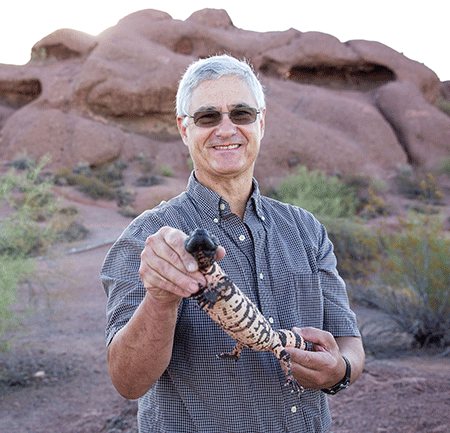This is a story about timing.
Specifically, how the Sonoran Desert’s most mysterious creatures delay leaving the nest until there’s a good food supply waiting for them. An Arizona State University study about Gila monsters was boosted by the lucky discovery of one particular nest of those shy, black-and-orange desert-dwellers famous for being venomous.
They were unearthed at the right time, by the right person, and science scored.
The perfect moment
Contractor Mike Pfander frames high-end homes in Tucson. He and his crew were excavating footings for an addition in the Catalina Foothills last October when they came across a clutch of hatching Gila monster eggs about 3 feet beneath the surface. A lifelong outdoorsman and amateur naturalist, he immediately recognized them.
“If I don’t eat it, I don’t kill it,” Pfander said. “I think they’re cool, and I wanted to save ’em.”
He called every herpetologist he could find. None of them believed him. Finally he contacted Roger Repp, a tool and die maker for the National Optical Astronomy Observatory and a rabid field herpetologist.
“For him, this was like Christmas, New Year’s and the birth of his first child all in one,” Pfander said. “It was a lot easier to find someone who knew how to take care of them. ... It was fun. We got a big charge out of it.”
Repp headed to the job site, collected the hatchlings, and brought them to ASU.
Excavation of the nest coincided with artificial incubation results, adding further credence to the study, which found for the first time proof of "overwintering" — hatching but remaining in the nest until conditions are ideal to emerge — by an animal other than an aquatic turtle. Pfander also got an acknowledgement in the Proceedings of the Royal Society BProceedings of the Royal Society is the parent title of two prestigious scientific journals published by the Royal Society. Originally a single journal, it was split into two separate journals in 1905. Series B publishes research related to biology., where the study was published in May.
“Serendipity works in strange ways,” he said.
Video by Deanna Dent/ASU Now
Resetting the clock
Gila monsters lay their eggs right around the start of the monsoon in midsummer; the rains give the eggs some moisture so they’re more likely not to dessicate. Eggs hatch in about 120 days, in October, “a bad time to pop out if your food doesn’t come out until May or later,” said associate professor Dale DeNardo, co-author of the study with Karla Moeller, both of the School of Life Sciences.
So it's the best time of year for the eggs to hatch, but not the best time for the babies to come out. There’s a mismatch. How do they deal with it? The hatchlings just lay low and procrastinate.
“For us, it’s ‘Oh, I’ll do that tomorrow,’” DeNardo said. “Their tomorrow is six months. Lizards don’t care. They can wait: They hatch with good fat and energy reserves.”
If the hatchlings emerged from the nest in spring, quail and rabbits are breeding, but their eggs and kits are too big for a little Gila to eat. Their food appears in summer, when other lizards begin laying eggs. Hatchlings start to emerge in late spring through summer.
“That’s the beginning of the food they can eat,” DeNardo said. “There’s no reason to come out until there’s food.”
Biding their time

ASU attending veterinarian Dale DeNardo holds up a Gila monster at Papago Park on July 5. Photo by Deanna Dent/ASU Now
Gila monsters are the biggest lizard in North America because they can only feed for short periods of time, so they have to store a lot of energy. They can also store a lot of water — about a quarter of their weight. It’s the only vertebrate that specializes in eating nest contents in the desert.
The discovery of this particular nest, at this particular time, added real-world evidence to the researchers' laboratory findings about how Gila monster young behave and revealed a compelling trait about how the lizards survive.
“This isn’t about Gila monster’s eggs hatching,” DeNardo said. “This is about a phenomenon we think is unique to aquatic turtles."
It’s thought that turtles are the only animals which hatch and then spend the winter in the nest because it’s too harsh for them outside. But Gila monsters have the same pattern of overwintering.
"Here we have something that’s not a turtle, not aquatic, doesn’t live in cold environments, and it lives in a desert where winters are not that cold," DeNardo said. "Everything is different about this animal.
“It’s this weird combination of things because you’ve got to get out of the egg, but you can’t do what the adults do. But here you have a species that lives in an environment where it doesn’t get that cold in the winter, the adults don’t winter underwater. The embryos would do fine during the winter. It’s the first time documenting that another species other than these turtles with unique characteristics do this.”
Top photo: A baby Gila monster hatches from its egg. Photo courtesy of Dale DeNardo
More Science and technology

ASU researcher part of team discovering ways to fight drug-resistant bacteria
A new study published in the Science Advances journal featuring Arizona State University researchers has found vulnerabilities in certain strains of bacteria that are antibiotic resistant, just…

ASU student researchers get early, hands-on experience in engineering research
Using computer science to aid endangered species reintroduction, enhance software engineering education and improve semiconductor material performance are just some of the ways Arizona State…

ASU professor honored with prestigious award for being a cybersecurity trailblazer
At first, he thought it was a drill.On Sept. 11, 2001, Gail-Joon Ahn sat in a conference room in Fort Meade, Maryland. The cybersecurity researcher was part of a group that had been invited…
